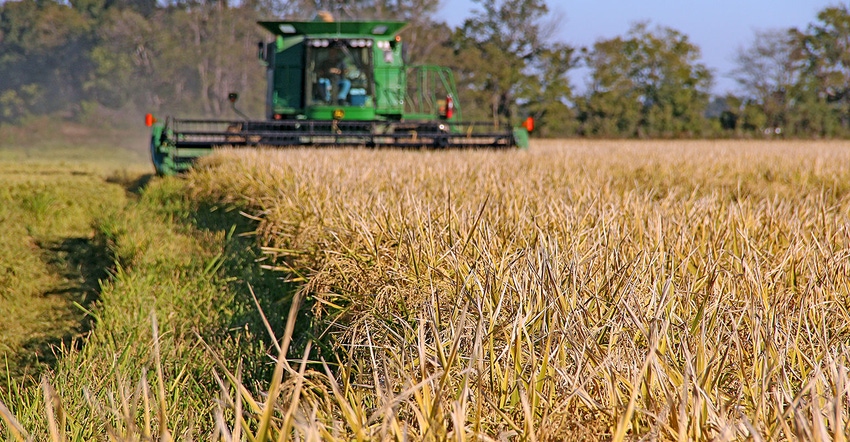June 10, 2019

Farmers in the world’s larger rice-producing countries are expected to grow less grain this year, but carryover supplies are so burdensome the declines are expected to have little impact on world rice prices.
The world could have nearly 700 million metric tons of rice on hand by the time the 2019-20 marketing year crops are harvested, according to estimates in USDA’s Foreign Agricultural Service Production, Supply and Distribution database.
“A large carry-in is projected to boost global rice supplies to record high levels in 2019-20 despite the fact the crop is projected slightly down,” said Dr. Nathan Childs, senior agricultural rice economist with USDA’s Economic Research Service, during a University of Arkansas System Division of Agriculture Food and Agribusiness webinar.
“The first projections early in the year are for a slightly smaller global production of about 498.4 million metric tons on a milled basis,” he said. “That is down about 1.5 million tons from this year's (2018-19) record.” (To watch the webinar, visit https://bit.ly/2wOQzKR.)
China, India and the United States are projected to all have declines. “China and India are the largest producers, and no one else is even close,” he said. “Between them they have 40 percent of global production.”
World rice supplies have been building since shortfalls in production led to food riots in some countries in 2006. Since then, rice supplies have set new records almost every year as producers in different parts of the world have harvested more grain.
“Global ending stocks are projected to reach 172 million metric tons, which would be up 2.2 million from 2018-19,” said Childs. “But the 1.4 percent increase is the smallest since they began rising in 2006.”
Fewer U.S. acres
U.S. farmers were expected to plant fewer acres of rice in 2019, but growers have struggled with difficult planting conditions almost since the first day soils were warm enough to plant in 2019. When Childs spoke on May 30, some were still planting while others had filed for prevented planting due to the unusually wet conditions.
“When USDA’s National Agricultural Statistics Service issued its planting intentions survey in March, expectations were U.S. growers would plant 2.87 million acres of rice, which would have been down just 2.6 percent from 2018,” Childs said. “With expectations of a very large carryout for 2018-19 and declining U.S. prices, I think almost everyone expected U.S. area to decline, but earlier expectations were for a larger decline.
USDA’s latest forecasts put U.S. long-grain acres at 2.15 million, which would be up 2.1 percent from 2018-18. Combined medium and short grain acres were indicated at 674,000 acres, which would be down 4.7 percent. Most of that decline would occur in California.
“California came in about 485,000 total,” he said. “It has the ability to plant in the low 500,000s so the 485,000 was somewhat low for California.”
All rice plantings were indicated lower in Arkansas, California and Louisiana with Arkansas accounting for more than half of the 76,000-acre intended plantings decline. Louisiana was indicated to be down about 40,000 acres.
“Really Arkansas and Louisiana were both down about 40,000, and I think California around 23,000,” Childs noted. “Plantings were indicated to be slightly higher this year in Mississippi, Missouri and Texas, but those were not big increases.”
Planting progress
Planting progress has been behind last year and behind each state’s five-year average most of the spring, especially in the Delta region of Mississippi, Missouri and Arkansas. “Louisiana was the only state in the South whose plantings were close to caught up although they are still a little behind.
“There is still time to catch up with the plantings, and the impact of late-planted rice on yield is hard to estimate at this time. Conditions in California have generally been favorable with reservoir levels and snowmelt above normal. While planting was slow at first, there were late-season rains and cooler than normal temperatures, and the planting pace has nearly caught up with last year. However, emergence remains well behind a normal.”
The first survey of actual plantings will be released on June 28, and those will be incorporated in the July World Agricultural Supply Demand Estimates from USDA.
“If you look at it, you can see a declining trend in U.S. rice area,” says Childs. “It used to be plantings in the low 3 million range were pretty common. Now it’s below 3 million. In the baseline projections we made last fall, we did not see the U.S. rice area reaching 3 million over the next decade.”
Rice crops are also projected to be smaller in Brazil, Ecuador, Madagascar, Mali, Paraguay, Sri Lanka, Taiwan and Venezuela, according to Childs. “Many of these countries are export-oriented, especially in southern South America, and prices are just not high enough to make rice competitive with other competing crop options. Brazil's area is probably the smallest in 60 to 70 years.”
On the other hand, larger rice crops are forecast in 2019-20 for Bangladesh, Burma, Cambodia, Cote d'Ivoire, Egypt, the European Union, Guinea, Guyana, Indonesia, Iraq, Laos, Nigeria, Pakistan, the Philippines, Senegal, Sierra Leone, Thailand and Vietnam.
“Several major exporters, all Asian and mostly Southeast Asia are expected to produce larger crops in 2019-20, many of them records,” he said. “Indonesia and Bangladesh now produce almost the same amount of rice. Ten to 15 years ago Indonesia harvested substantially more rice than Bangladesh, but Bangladesh has been increasing rice production.”
For more on the University of Arkansas Food and Agribusiness webinars, visit https://www.uaex.edu/farm-ranch/economics-marketing/food-agribusiness-webinars/.
About the Author(s)
You May Also Like






